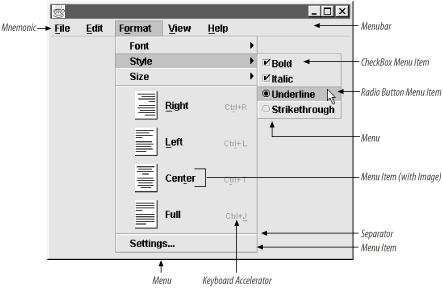Introducing Swing Menus
Swing menu components are subclasses of JComponent. Consequently, they have all the
benefits of a Swing component, and you can treat them as such with
respect to layout managers and containers.
Here are some notable features of the Swing menu system:
Icons can augment or replace menu items.
Menu items can be radio buttons.
Keyboard accelerators can be assigned to menu items; these appear next to the menu item text.
Most standard Swing components can be used as menu items.
Swing provides familiar menu separators, checkbox menu items, pop-up menus, and submenus for use in your applications. In addition, Swing menus support keyboard accelerators and “underline” style (mnemonic) shortcuts, and you can attach menu bars to the top of Swing frames with a single function that adjusts the frame insets accordingly. On the Macintosh, your application can be configured so that this method places the menu bar at the top of the screen, where users expect to find it. Figure 14-1 defines the various elements that make up the menu system in Swing.

Figure 14-1. The elements of the Swing menu system
Note that not all platforms support underline-style mnemonics. Notably, on the Macintosh (which has never provided this sort of user interface) mnemonics do not appear at all in the system menu bar, and though they are visible in the actual menus, they do not work in either place. If your ...
Get Java Swing, 2nd Edition now with the O’Reilly learning platform.
O’Reilly members experience books, live events, courses curated by job role, and more from O’Reilly and nearly 200 top publishers.

